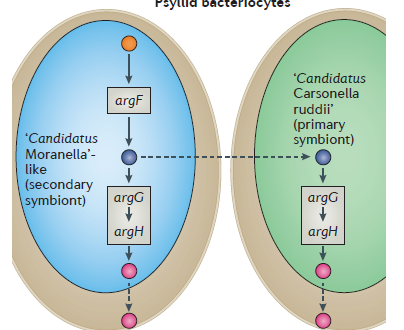Healthy animals are colonized by microorganisms routinely. The Human Microbiome, for example, is restricted to five body sites, such as skin, oral cavity, pulmonary tract, gastrointestinal tract, and urogenital tract. Some animals are, however, colonized by substantial populations of microorganisms at sites inside of the body wall, e.g. in the blood or within (or between) cells of specific organs and hence, these internal microorganisms are termed as endosymbionts.
An endosymbiont or endobiont is any organism which lives within the body or cells of another organism (as host) in a mutualistic relationship, often but not always to mutual benefit. Endosymbiosis, though are widespread in insects along with some other invertebrate groups but are exceptionally rare in vertebrates. The only intracellular endosymbiont described in vertebrates is the alga Oophila amblystomatis in embryos of the spotted salamander Ambystoma maculatum.
This endosymbiotic relationship has significantly contributed to the evolution of life on earth. The endosymbionts have the capability to induce a multitude of different phenotypes, for example, changing of host sex ratios, defense against pathogens as well as the behavior of host organisms. Among these relationships, at least 15-20% of all insects have been estimated as bacterial symbioses. Endosymbiosis evolved due to drastic genome reduction. As a consequence of loss of selection of multiple gene functions, free-living bacteria became host-associated and started the process of genome reduction.
Plant sap-feeding insects of the order Hemiptera have emerged in recent years as informative systems to study endosymbiosis. Drastic genome loss for the synthesis of essential amino acids forced microbes to seek shelter in these insects, therefore, the endosymbionts provide the insect with essential amino acids (EAAs) that are not synthesized de novo by animals while these EAAs are scarce in plant sap. This endosymbiosis relationship makes the plant sap-feeding insects to survive with enough essential amino acids that act as building blocks of proteins.
References:
1) How multi-partner endosymbioses function. (doi:10.1038/nrmicro.2016.151)
2) Genome Reduction and Co-evolution between the Primary and Secondary Bacterial Symbionts of Psyllids. (doi:10.1093/molbev/mss180)
Best safe and secure cloud storage with password protection
Get Envato Elements, Prime Video, Hotstar and Netflix For Free
 Plantlet The Blogging Platform of Department of Botany, University of Dhaka
Plantlet The Blogging Platform of Department of Botany, University of Dhaka






Your point of view caught my eye and was very interesting. Thanks. I have a question for you.